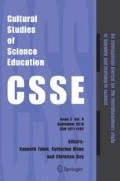Abstract
This paper summarizes how collaborative online projects (COPs) are used to facilitate science content-area learning for English Learners of Hispanic origin. This is a Mexico-USA partnership project funded by the National Science Foundation. A COP is a 10-week thematic science unit, completely online, and bilingual (Spanish and English) designed to provide collaborative learning experiences with culturally and linguistically relevant science instruction in an interactive and multimodal learning environment. Units are integrated with explicit instructional lessons that include: (a) hands-on and laboratory activities, (b) interactive materials and interactive games with immediate feedback, (c) animated video tutorials, (d) discussion forums where students exchange scientific learning across classrooms in the USA and in Mexico, and (e) summative and formative assessments. Thematic units have been aligned to U.S. National Science Education Standards and are under current revisions for alignment to the Common Core State Standards. Training materials for the teachers have been integrated into the project website to facilitate self-paced and independent learning. Preliminary findings of our pre-experimental study with a sample of 53 students (81 % ELs), distributed across three different groups, resulted in a 21 % statistically significant points increase from pretest to posttest assessments of science content learning, t(52) = 11.07, p = .000.


Similar content being viewed by others
References
Atwater, M. M. (1994). Equity for black Americans in precollege science. Science Education, 84(2), 154–179.
Baddeley, A. D. (1986). Working memory. Oxford, England: Oxford University Press.
Barba, R. H. (1993). A study of culturally syntonic variables in the bilingual/bicultural science classroom. Journal of Research in Science Teaching, 30, 1053–1071.
Biological Sciences Curriculum Study. (2012). Retrieved from http://www.bscs.org/about.
Bodley, J. H. (1997). Cultural anthropology: Tribes, states, and the global system. Mountain View, CA: Mayfield Publishing Company.
Buxton, C. (1999). Designing a model-based methodology for science instruction: Lessons from a bilingual classroom. Bilingual Research Journal, 23(2–3), 147–177.
Chisholm, I. M., & Beckett, E. C. (2003). Teacher preparation for equitable access through the integration of TESOL standards, multiple intelligences and technology. Technology, Pedagogy and Education, 12(2), 249–275.
Cummins, J. (1981). Bilingualism and minority-language children. Toronto, Canada: OISE Press.
Garcia, E. E. (1988). Effective schooling for language minority students (New Focus No. 1). Washington, DC: National Clearinghouse for Bilingual Education.
Hampton, E., & Rodriguez, R. (2001). Inquiry science in bilingual classrooms. Bilingual Research Journal, 25(4), 461–478.
Hutchison, C. B. (2005). Teaching in America: A cross-cultural guide for international teachers and their employers. Dordrecht, The Netherlands: Springer.
Lee, O. (2005). Science education with English language learners: Synthesis and research agenda. Review of Educational Research, 75, 491–530.
Lee, O., & Fradd, S. H. (1996). Interactional patterns of linguistically diverse students and teachers: Insights for promoting science learning. Linguistics and Education: An International Research Journal, 8, 269–297.
Mayer, R. E. (1997). Multimedia learning: Are we asking the right questions? Educational Psychologist, 32, 1–19.
Mayer, R. E. (2001). Multimedia learning. New York: Cambridge University Press.
Moreno, R., & Mayer, R. E. (2000). A learner-centered approach to multimedia explanations: Deriving instructional design principles from cognitive theory. Journal of Computer-Enhanced Learning, 2(2). Retrieved from http://imej.wfu.edu/articles/2000/2/05/index.asp.
Moreno, R., & Mayer, R. E. (2007). Interactive multimodal learning environments special issue on interactive learning environments: contemporary issues and trends. Educational Psychology Review, 19(3), 209–326.
National Center for Education Statistics. (2009). The Condition of Education. Washington, DC: U.S. Department of Education, Institute of Education Sciences. Retrieved from http://nces.ed.gov/programs/coe.
National Center for Education Statistics. (2012). The Nation’s Report Card: Science 2011. Retrieved from http://nces.ed.gov/nationsreportcard/pubs/main2011/2012465.asp.
National Research Council. (1996). National science education standards. Washington, DC: National Academy Press.
National Science Foundation. (1996). Review of instructional materials for middle school science. Washington, DC: Author.
Oregon Department of Education. (2011). Report Card—Statewide Annual 2010–2011. Retrieved from http://www.ode.state.or.us/data/reportcard/reports.aspx.
Paivio, A. (1986). Mental representation: A dual coding approach. Oxford, England: Oxford University Press.
Rakow, S. J., & Bermudez, A. B. (1993). Science is “Ciencia”: Meeting the needs of Hispanic American students. Science Education, 77, 547–560.
Slattery, J. (2004). Counseling diverse clients, bringing context into therapy. Toronto, Ontario: Brooks/Cole.
Sweller, J., & Chandler, P. (1994). Why some material is difficult to learn. Cognition and Instruction, 12, 185–233.
Torres, H. N., & Zeidler, D. L. (2002). The effects of English language proficiency and scientific reasoning skills on the acquisition of science content knowledge by Hispanic English language learners and native English language speaking students. Electronic Journal of Science Education, 6(3). Retrieved from http://wolfweb.unr.edu/homepage/crowther/ejse/torreszeidler.pdf.
U.S. Census Bureau. (2009). The 2012 Statistical Abstract: The National Data Book Allegany County: NY. Retrieved from http://www.census.gov/compendia/statab/2009/2009edition.html.
U.S. Department of Education. (2010). Building the Legacy: IDEA 2004. U.S. Department of Education. Retrieved from http://idea.ed.gov/explore/home.
Author information
Authors and Affiliations
Corresponding author
Additional information
Lead editors: Alejandro Gallard Martínez and Rene Antrop González.
Appendix
Appendix
What Your Body Needs, Stage 2, Lesson 2—Outline 
What Your Body Needs, Stage 2, Lesson 2—Warm-up 
What Your Body Needs, Stage 2, Lesson 2—Learning the content 
What Your Body Needs, Stage 2, Lesson 2—Enhanced vocabulary 
What Your Body Needs, Stage 2, Lesson 2—Interactive 
What Your Body Needs, Stage 2, Lesson 2—Interactive Microscope 
What Your Body Needs, Stage 2, Lesson 2—Lab Activity  .
.
Rights and permissions
About this article
Cite this article
Terrazas-Arellanes, F.E., Knox, C. & Rivas, C. Collaborative online projects for English language learners in science. Cult Stud of Sci Educ 8, 953–971 (2013). https://doi.org/10.1007/s11422-013-9521-8
Received:
Accepted:
Published:
Issue Date:
DOI: https://doi.org/10.1007/s11422-013-9521-8



